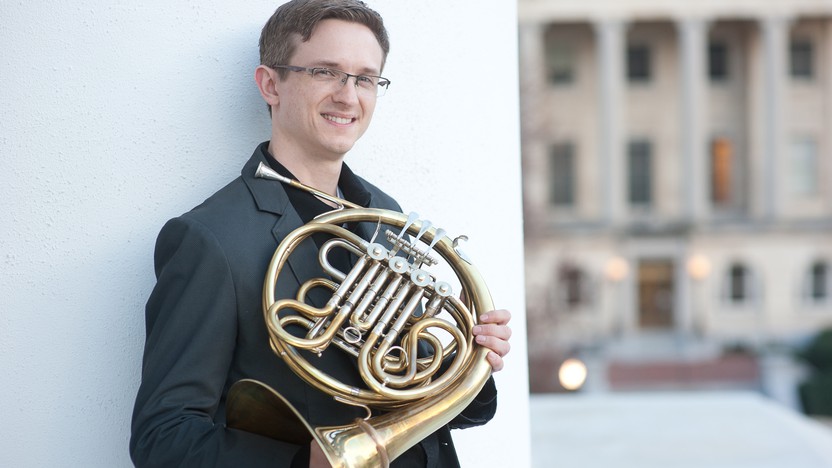James Ferree Plays Mozart’s Fourth Horn Concerto



Growing up in the Atlanta area, TJ Cole began writing music at the piano at six, and by 12 they had already self-produced an album of original compositions. They attended high school at the prestigious Interlochen Arts Academy, and continued studies at the Curtis Institute of Music as a student of Jennifer Higdon. At 21, Cole wrote Death of the Poet for string orchestra, their response to the painting “Death of the Poet Walter Rheiner” by Conrad Felixmüller that they had seen two years earlier at the Art Institute of Chicago.
“The painting was enormous,” Cole wrote in a program note, “with a contorted figure suspended in the air, but the colors were what struck me the most. The artist used vibrant and deep blues, purples, reds and greens to portray this night scene. I’ve always connected strongly to colors, so my reaction to the painting was an emotional one. The figure in the painting, Walter Rheiner, was a poet and close friend of Felixmüller. The painting shows Rheiner’s last moments before his death, which inspired me to compose Death of the Poet in the style of an Elegy.”
Aaron Grad ©2022

Growing up in Salzburg, Wolfgang Amadeus Mozart developed a lasting bond with Joseph Leutgeb, a longtime horn player in the local archbishop’s court orchestra and a dear family friend. When Leutgeb moved to Vienna in 1777 to take over a small cheese shop, Mozart’s father Leopold lent him some money; during the financial struggles that marred the end of young Mozart’s short life, Leutgeb returned the favor.
Their friendship was cemented in a series of works that Mozart wrote after his own move to Vienna in 1781, including this concerto from 1786. The nature of the valveless horn from that period made it challenging to play smooth melodic lines, but Leutgeb was a master of the various lip and hand maneuvers that made it possible to fill in the missing notes, as demonstrated by the linear melodies Mozart wrote in the first movement.
A review in Paris once singled out Leutgeb’s ability to “sing an adagio as perfectly as the most mellow, interesting and accurate voice,” a talent that Mozart put to use in the central Andante that was to be played “cantabile” (i.e. in the manner of singing). Drawing on the traditional use of the horn as an instrument that announced the hunt with its leaping intervals, this concert’s hunt-inspired finale leans into the horn’s outdoor origins.
Aaron Grad ©2022

When the 21-year-old Ludwig van Beethoven arrived in Vienna in 1792, Wolfgang Amadeus Mozart had been dead less than a year, and Franz Joseph Haydn — with whom Beethoven studied briefly — was in his prime. Under their long shadows, Beethoven spent his first years in Vienna mastering the “Classical” style, meanwhile earning a reputation as the city’s ranking keyboard virtuoso. If any one day marked his arrival as a composer of note, it must have been April 2, 1800, when he produced his first benefit concert in Vienna. Besides leading an orchestra in a Mozart symphony and excerpts from Haydn’s oratorio The Creation, Beethoven performed one of his own piano concertos, and he debuted both the Symphony No. 1 and the Septet in E-flat, which stole the show.
In the spirit of Mozart’s serenades, the Septet was a musical confection with no higher aim than to entertain and delight its audience. (Well, it may have had one other aim: Beethoven was trying to gain favor with the work’s dedicatee, Empress Maria Theresa.) In later years, Beethoven would back away from the success of his Septet, which remained one of his most popular works in his lifetime and which spawned numerous adaptations, including Beethoven’s own reduction for clarinet, cello and piano.
It would be wrong to discount the innovations that flow under the cheerful surface of the Septet, particularly in the novel use of a mixed ensemble of strings and winds. Just as Beethoven’s First Symphony attracted attention for emancipating the woodwinds from a supporting role, the Septet assembled the clarinet, bassoon, horn, violin, viola, cello and bass as a band of equals. The clarinet shares melodic duties with the violin, and the omission of a second violin opens sonic space for the accompanying textures of the horn and bassoon. The first movement in particular maximizes that coloristic range, setting up contrasts among the elegance of a string trio, the breeziness of a wind trio and the full force of the miniature orchestra. In the slow movement that follows, some of the most sublime moments are those that cut against the instrumental typecasting, as when the bassoon and cello each climb into their upper ranges to deliver poignant lines.
The third movement, a Minuet, reuses a theme from Beethoven’s Piano Sonata in G, Op. 49, No. 2 (completed in 1796, its high opus number notwithstanding). For the fourth movement, the theme-and-variations structure invites myriad instrumental combinations, including spare textures for string duo and trio in the first variation and bare duets for clarinet and bassoon in the third.
In the quick Scherzo, the main motive takes its shape from the characteristic intervals of horn calls. The finale, in a bit of a twist, enters with a slow introduction, set in the parallel minor key. The Presto tempo soon brushes away that drama and tension, and the sprint to a buoyant conclusion only halts momentarily for a violin cadenza.
Aaron Grad ©2025
Get driving directions and find nearby parking.
Find dining options close to the venue.
View seating charts to find out where you'll be seating.
Get driving directions and find nearby parking.
Find dining options close to the venue.
View seating charts to find out where you'll be seating.
